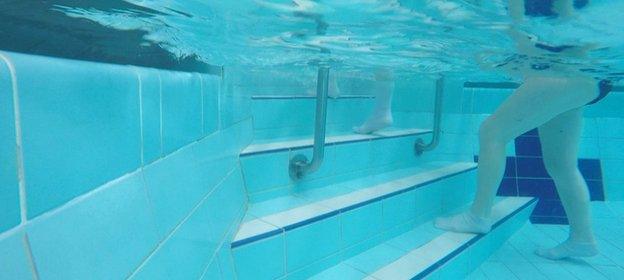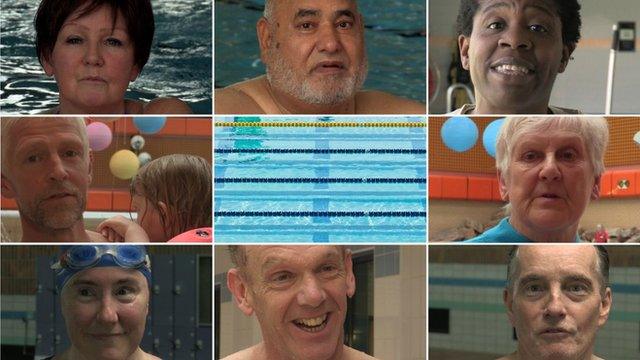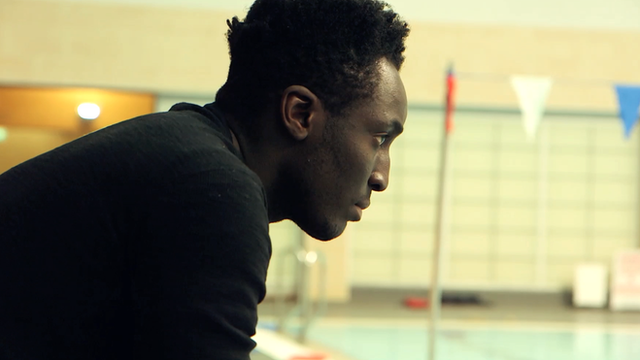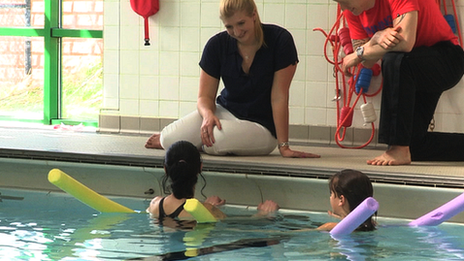Make Your Move: Alternatives to ladders for pool access and swimming
- Published
Would you like to go swimming but have concerns about getting in and out of the pool?
Pool ladders may not be an option for everybody - perhaps because of a disability, medical condition or injury.
Make Your Move has spoken to a number of people who use other methods for accessing the pool.
Steps or slope

Margaret Findlay (left) and Betty McKelvie (bottom right) take part in an aqua-aerobics class
Margaret Findlay, 78, said she prefers to use steps or a gradual slope into the water.
"I'd be afraid of using pool ladders because I can't swim," she said.
She takes part in an aqua-aerobics class at the Port Glasgow Swimming Pool, external with her friend Betty McKelvie.
"I like the atmosphere and it keeps me active," Margaret added.

Steps can make it easier to get in and out of the pool
"At one point I wouldn't leave the side of the pool."
Betty, who grew up near the River Clyde, added: "She's getting more adventurous now - it makes you push forward.
"My mother used to say don't go near the water so I never learnt to swim, but I made sure my three boys could swim.
"I just come into the water to have some fun and to meet people," added the 84 year old.
Hoist
Kellyanne Deveaney uses a wheelchair lift to access the pool
Kellyanne Deveaney, 35, uses a hoist to access the pool during her swim sessions with a carer from the social care charity, Quarriers., external
"It's not as easy as you think," she said, "but I've got used to it.
"My swimming is really important.
"It feels dead weird getting out of your chair - you're in a different position."
Goz Ugochuckwu said the thought of having to use a hoist sometimes put her off going swimming.
"It's just really embarrassing and I just don't like it," she said.
"I can't get from the floor to the wheelchair, so I have to use a hoist to get out the pool.

Despite the "rigmarole" of a hoist, Goz Ugochuckwu says it's worth it
"It can take a long time to find someone to operate it, and everyone is looking at you."
However, despite the "rigmarole" of getting into the pool she said it was worth it.
"I do really enjoy swimming - it's the freedom that you get.
"Being in a wheelchair, it just gives you that utter feeling that you can move every part of your body.
"It's one of the easiest forms of exercise and doesn't involve anyone else - apart from getting into the pool!"
Submersible lift - Poolpod

Evelyn Eunson uses a submersible lift to access the pool at the Pickaquoy Leisure Centre in Kirkwall, Orkney
"It's been a wonderful thing," according to Evelyn Eunson, "The first time you use it you feel a bit embarrassed but now I don't even think about it."
The 'Poolpod', external was the result of a design competition led by the Olympic Delivery Authority ahead of the London 2012 Games to improve disabled pool access.
About 55 pools across the UK now have this type of submersible lift, with about another 30 due for installation this year.
Evelyn, 61, said: "It has made ever such a difference because I wouldn't have been able to go up and down the steps with my sciatica.
"Both legs were troubling me - I probably wouldn't be able to go to the 'wellness sessions'.
"This means I can continue going."
Evelyn chooses to stand on the lift to enter the water, but it can also be used with the accompanying submersible wheelchair.
"My daughter used it with the wheelchair after she damaged her Achilles," she said.
"She came in on her crutches, then went on the wheelchair to get to the poolside and get lowered into the water.
"The Poolpod is very accessible. It's there all the time, and it doesn't have to be taken out for you.
"When the pool attendants see me coming they get it ready - I don't even have to ask now, it's lovely."
Using a Poolpod submersible lift to enter the water (Footage from The Pickaquoy Centre in Kirkwall, Orkney)
Make Your Move is hosting a live Facebook Q&A with Rebecca Adlington, Mark Foster and Dr Victoria King to discuss anything and everything to do with getting started at the pool.
You can join the conversation now and send in your questions using #MakeYourMove on Twitter. You can also email makeyourmove@bbc.co.uk, external.
Watch and take part in the Q&A at 11:30 GMT on Thursday, 19 May on the BBC Get Inspired Facebook page, external.
- Published13 May 2016

- Published13 May 2016

- Published27 March 2018

- Published6 August 2015

- Published26 July 2013
